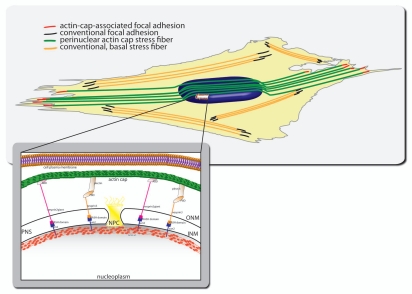Figure 2.
Schematic of subcellular organization of the perinuclear actin cap and associated focal adhesions. The actin cap is tightly connected to the apical surface of the nuclear envelope, not to the plasma membrane. Inset. Physical connections between the actin cap and the nucleus are mediated by components of the linker of nucleoskeleton and cytoskeleton (LINC) complexes, including Nesprin-3 and Nesprin-2giant, which are connected to the nuclear lamina through SUN proteins. Disruption of LINC complexes specifically disorganizes or eliminates the actin cap, without significantly affecting conventional stress fibers located at the basal surface of adherent cells. Similarly, treatment of cells with low dose (60 nM) of the F-actin-depolymerizing drug latrunculin B only affects the actin fibers of the actin cap because the actin cap is much more dynamic than conventional basal actin fibers. Actin filament bundles in the actin cap are terminated by specialized focal adhesions, which we name actin cap-associated focal adhesions. There are about ten actin cap-associated focal adhesions per cell. Actin cap-associated focal adhesions are restricted to the cell periphery and are larger and longer than conventional focal adhesions, which terminate conventional basal stress fibers.

